On Monday I decided to try my hand at making Hot Process (HP) soap for the first time. It’s been on my list of things to do for aaaaages, and I even bought a fancy pants slow cooker / crock pot before Christmas in readiness, but the time was never right. Recently however I was contacted by Plastic Free Snowdonia, a group who, as the name suggests, are trying to reduce the amount of plastic being used in this area. They were interested in solid shampoo bars, which I’ve not made for a while, and I decided that this was the perfect opportunity to try out the HP method. My starting point was this tutorial by Sarah of Sas-Oki Soap and while clearly I am in no position to write a HP tutorial, being an absolute beginner, I did take a load of photos and so I thought I’d share the experience with you.
In the past I’ve used Liz Ardlady’s shampoo bar recipe, but used water instead of the apple cider vinegar (ACV), and left out the sodium lactate. I should confess that I’ve never used the original recipe as written, but I’ve always been really happy with the final bars without the ACV, so I decided to use the same recipe for my foray into Hot Process.
I put all the fats into the slow cooker and while they were melting down I made up the lye solution.
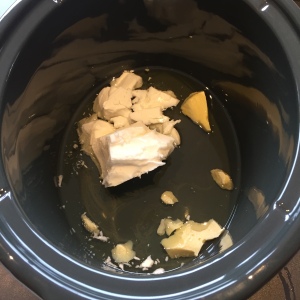
Oils & Butters Melting
Off I went to do something else, and of course by the time the lye solution had cooled down, the fats were waaaaay to warm, so I popped them out into the snow to cool down 😀
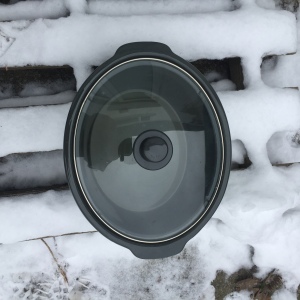
Oils & Butters Cooling
Once everything was cool enough I added the lye to the oils and gave it all a quick stick blend to emulsify:

Lye added and stick-blended to emulsification
I turned the crockpot onto ‘medium’, covered the top with some cling film before putting the lid on to keep the moisture in (a tip I got from the Modern Soapmaking HP tutorial) and let it do its thing. Another tip from the Modern Soapmaking tutorial was NO STIRRING. So all I did was take a photograph every ten minutes or so.
This one was after 10 minutes cooking – the soap is beginning to saponify round the edges. Apologies for the quality of these photos, there was condensation forming on the cling film over the pot:
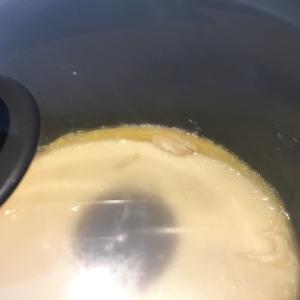
After 10 mins cooking
After 20 mins cooking:
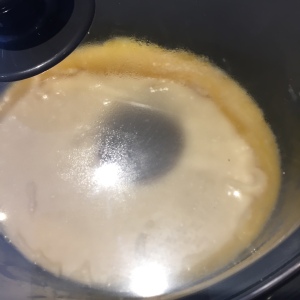
After 20 mins cooking
The soap continued to cook, and change colour as time went on. This was what it looked like after 40 mins, and it didn’t really change appearance for the next 10 minutes or so. I decided it might be ready. All tutorials I’ve read have recommended using an infra-red thermometer to check readiness, but I don’t have one, so was winging it…

After 40 mins cooking
So a the 50 minute mark I removed the lid and the cling film, gave it a good whisk, then did the zap test. For the uninitiated, the zap test is the process whereby you remove a small amount of soap from the pot and touch the tip of your tongue to it. Yep, you LICK potentially caustic soap. Sounds crazy I know, but it’s a time honoured method of checking whether soap has fully saponified. If it simply tastes, erm, soapy, it’s good to go. If it zaps (and trust me, you’ll know what I mean if it happens to you) it’s not yet ready. Oh, and please don’t put the licked soap back into the pot!! 😀

Fully cooked soap, whisked
I then added some grapefruit essential oil, and whisked that in thoroughly before the soap was spooned (actually, plopped and stuffed) it into the mould… It was very thick, and solidifying very quickly. I’ve read that adding yoghurt, (or coconut cream/milk for a vegan version) can be added at this point to help fluidity – I’ll be trying that next time.

Solid shampoo freshly plopped into the mould
I scraped the last bits out of the pot and rolled them into little balls – with my bare hands!!! I know, I know, I wouldn’t normally do it but these balls at least are for my own personal use only. And the novelty of being able to squidge soap that’s straight out of the pot with my bare hands was irresistible 😀
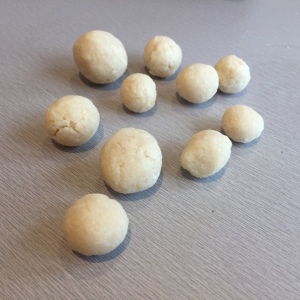
Shampoo Balls
Two days later the soap has become even more opaque:

Shampoo Bars in the mould after 48 hours
I unmoulded the bars, and then cut them in half. These bars are going to be sent out as testers as, although I personally love this recipe, I want as many opinions as I can get before I think about selling this solid shampoo.

Unmoulded Shampoo Bars

Cut Shampoo Bars
There seems to be conflicting opinions regarding how long Hot Processed soap should be cured for. Strictly speaking, it’s safe to use straight out of the mould, as the process of saponification has completed in the pot. I did use one of my little balls of shampoo on the same day as I made it, and it worked perfectly. However, as with CP soap, the bars were still somewhat soft when they came out of the mould, and I’m definitely going to give them an as-yet-undetermined cure time to dry out and harden up a bit. I’ve weighed one of the bars and I’ll monitor the weight reduction on a regular basis and report back when it’s ready.
I’m surprisingly thrilled with the result. It’s not very pretty. Not pretty at all actually. But it’s quick & easy and the clean up process is an absolute doddle and I’ll definitely be doing it again. If you have any tips I’d love to hear them – pleeaaaase 🙂
Thanks for reading,
Vickx

Amazing! It’s been on my “to do” list too, but I just haven’t gotten around to trying it yet. Good job!
Me too! It’s high up there on my list of things to do before I leave China.
Go for it!
Thanks, I enjoyed it, and the result, far more than I expected to 😄
Pingback: The Week in Soap: 4th March ’18 | The Soap Mine
Hi Vicki!
Thanks for the great post on HP! I made it once, when I was a new soaper and it turned out well, but haven’t tried it since.
I have made a lot of shampoo bars (for the past 6? years) and really like them – but I do it CP.
I have read lots of info about using ACV and how important it is to use as a rinse, which I’ve done a few times….until I came across some info on ACV that it will strip the color out of your hair (if you color or highlight it) and will make it very dull…which I actually noticed when I used ACV myself.
So I’m glad you didn’t add it to your ingredients….doesn’t everyone color/highlight their hair? It seems like it to me… (I know it’s bad and someday I will let the grey come through, but not yet!)
I enjoyed the post and all the photos!
Thank you so much!
Sly
I’ve always made CP shampoo in the past too, but it’s been a while. I’ve never had any problems using it personally but I’ve not tried to sell it as I’ve always been put off by this (apparent) NEED for an AVC rinse. I’ve never noticed any of this so called ‘build up’ myself, but I can see why some people with longer hair might need to follow up with a conditioner of some sort.
Haha – well done, although I did have bit of a giggle about the plastic wrap (given the plastic free mob you were soaping for!).
I think there is way too much mystique about HP – in the end all you are doing is forcing the saponification. I have found the time taken to be dependant on the outside temperature – and the “stir or not stir” thing is purely personal preference. I stir because the temperature of my crockpot is uneven – the edges heat faster than the middle.
The curing after the cook is just to let it dry out and not be so soft and use up quick – but this will also depend on what oils you use in the batch. If you want a good measure of how long to leave it you can weight the batch every few days and when it stops changing weight, most of the excess water will have left, and it will be as hard as it will get.
I have been reading a book called “Scientific Soapmaking” (Kevin M. Dunn) which is good for the science facts of sopamaking.
I think you’re right about the mystique, it was a lot easier and more straightforward than I thought it would be. I understood that by not stirring and putting wrap on the top, less liquid would evaporate and therefore the soap would be more fluid, bunt there was nothing fluid whatsoever about what came out of that pot 😂. I did weigh one bar in order to do just what you suggest re the cure/drying time, so I’ll see how that goes 👍🏻
Sorry – “soapmaking” – currently being driven mad by the “look at me” incessant shrieks of my 2 and 4 yr old grandkids!! How come kids these days always need an audience!! LOL
Sarah : )
🤣🤣
Pingback: The Week in Soap: 11th March, ’18 | The Soap Mine
Soooooo…. curious minds want to know. I am keen to give this a go today and need to end results! How did it harden up? Did you notice a difference between hp and cp? Looks?
It’s still losing weight, which is why I’ve not done a follow up post yet. It’s definitely nice t as as hard as my CP soap yet, and still looks very rustic, but I’ve been using nothing else on my hair since I made it an I LOVE it.
*not* as hard…
I can’t wait to hear the results! I was going to make some today but thought I’d wait to hear from you!
HP is a great way to restock quickly. You can’t make your exquisite tops, but having some rustic bars is ok too. They will save you a lot of angst.
Absolutely – I’ll definitely be making more soon (ish 😂)